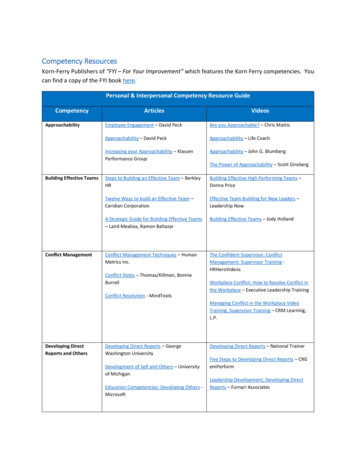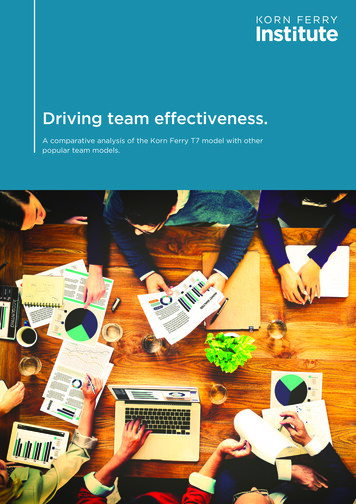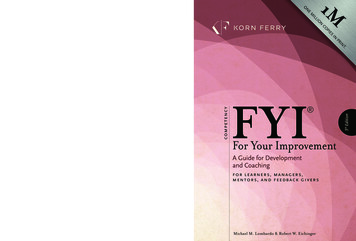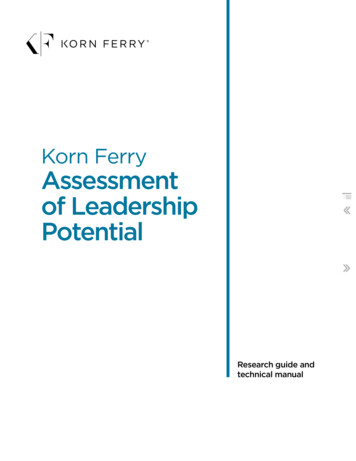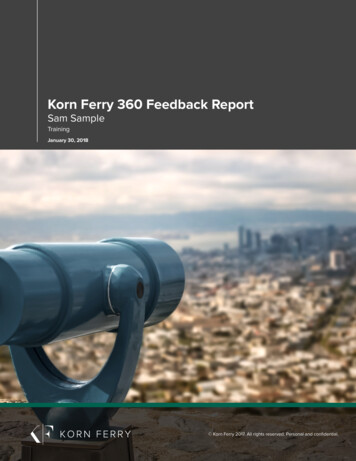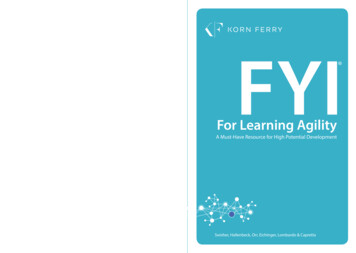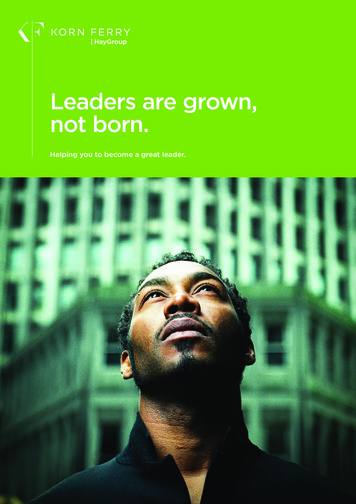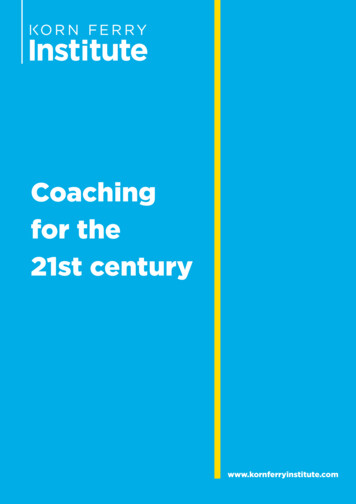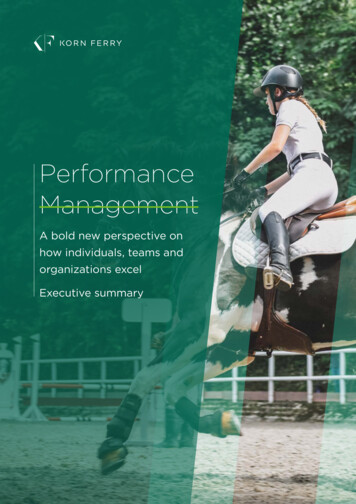
Transcription
PerformanceManagementA bold new perspective onhow individuals, teams andorganizations excelExecutive summary
IntroductionAlmost nobody we speak to in thecorporate world seems satisfied withtheir performance managementprocess—and absolutely nobodyknows what to do about it. But webelieve our recent research could provea turning point. Our conversationswith 67 top-flight performers fromoutside industry have opened oureyes to a new mindset and approachthat could enable organizations tocrack the age-old problem of howto cultivate feedback conversationsthat consistently drive improvementsin performance.“Our conversations with67 top flight performersfrom outside industryhave opened our eyesto a new mindset andapproach to performancemanagement.”2This approach rejects much of the conventionalcorporate wisdom on performance management.It involves a radical simplification of traditionalpractices and processes. It makes feedbackconversations a normal and daily feature of theworkplace. Central to this is the replacement ofbackwards-looking annual reviews with cycles thatare linked more closely to the rhythm of work.At the same time, organizations must develop,embed and sustain the right conditions to enablefree-flowing feedback to thrive. These includea shared performance purpose, a strong culturaland values framework, and an inclusive climate ofpsychological safety, where any perception of threator fear relating to feedback has been removed.Individuals in the organization also have a criticalrole to play. Leaders need to be trained in humanbehavior from as early as possible in their careers.Only then will they be able to provide effectivefeedback in the moment and tailor it to everyindividual’s needs.As receivers, meanwhile, we all need to learn toseek out, accept and understand performancefeedback, and use it to drive improvementson a day-to-day basis. This will be made easierif feedback is normalized throughout people’scareers, but particularly in the early stageswhen it can help build the self-awareness thatis a critical building block of high performance.The ultimate aim should be to move to a more fluid,non-linear world of performance management,where feedback is a natural, regular and highlypersonalized endeavor involving close collaborationbetween feedback giver and feedback receiver.They are already doing it—to outstanding effect—infields ranging from theatre, dance, film and TV tomedicine, the military and the emergency services.So, why can’t we?
Home truthsWhat’s wrongwith performancemanagement?Over time, organizations have evolved a complex webof formal and informal links between performancemanagement and other critical areas of intervention.This has been driven by the desire to “optimize returnon investment,” pursue “HR process effectiveness,”deliver “technology enablement” or “HR dataanalytics and intelligence” and other similar buzzphrases. These may all be valid aims. But do theyreally support the primary goal of performancemanagement, which is—let’s not forget—todrive performance?Let’s get back to basicsResearch has shown that changes to best-practiceperformance management techniques—ratings,structure, process—have minimal impact on drivingperformance when compared to feedback culturepractices. The criticality of “feedback” in shapinggrowth, improvement, and course correction wasuniversally recognized and highlighted as key tohigh performance by our research participants.“Feedback is the only wayto improve in rowing. Youcome off the water andanalyze immediately. Thisfeedback loop—three times aday—ensures you constantlydo what is needed. If youleave [it] until later, you mayforget or dwell on it andget stressed.”Alex Partridge, British Olympian3Make feedback partof the dealEveryone we spoke to, no matter what theirbackground, cultural context or field, has a mutualhunger and expectation for feedback. For them,it is not a tool to be brought out on specialoccasions; it is a cultural thread that runs througheverything they do. We need to make feedbackpart of our culture in the corporate world too. And,crucially, this isn’t just about top-down, hierarchicalfeedback-giving; this is a mindset that everybody inthe organization needs to embrace.In this paper we outline three key findings from ourresearch that enable effective feedback-giving:1 Getting the environment right2 Helping our leaders see the person3 Growing feedback-hungry individualsidualsAnd, we draw on these lessons to suggest a newway forward for performance management.
1. Getting theenvironment rightEffective performance conversations do notjust happen by chance. It is critical to develop,embed and sustain the right conditions toenable free‑flowing feedback to thrive within anorganization. Our research found that there werethree important dimensions required to help thiswork effectively:1. A shared performance purposefor the team and individual aroundwhich everyone is galvanized.There has already been extensive research tosuggest that purpose-oriented companies exhibithigher levels of innovation, employee retention,and productivity than their competitors.What we discovered was that a sharedperformance purpose is also critical to unlockingfeedback flow. This was particularly true withinthe complex dynamic of the sports squad, whereselection pressure means that you are bothcompeting with your peers for a place on the teamand, at the same time, united around the commonperformance purpose of collective success forthe group.Creation of a shared performance purposeencourages people to seek out, accept andunderstand feedback because there is a contextand direction to it.2. A strong cultural andvalues framework.Culture and values provide an important pointof reference for self- and team-analysis, ensuringthe whole team stays “on-purpose.” It also helpsto prevent complacency. When your team keepswinning, poor habits will often kick in. Culture andvalues help everybody in the team to recognizecomplacency and understand the standards they,as a group, need to be hitting to achieve theircollective goal.This helps break down traditional linear feedbackchannels. Instead, feedback becomes just “what wedo around here,” and is given and received acrossthe peer group.4
3. An inclusive climate ofpsychological safetyTimothy R. Clark defines psychological safetyas, “a condition in which one feels (a) included,(b) safe to learn, (c) safe to contribute, and (d)safe to challenge the status quo, without fear ofbeing embarrassed, marginalized or punished insome way.”For performance management purposes, thismeans an environment in which people do notfeel threatened by feedback, and where theyknow they won’t be punished for making a mistake.And, critically, a safe environment is easier toachieve if you have strong purpose, culture andvalues in place.“Some players become informalleaders. They tend to be those whoembody the culture and make harddecisions look easy. They then guidepeers in a positive way and becomecurators, influencers, and hold themost weight. To be successful you needeveryone to align and point the sameway as the organization and strategy.”Gordon D’Arcy, Former Irish Rugby PlayerSort the timingof feedbackWhen it comes to increasing the impact ofperformance management, we think one of themost significant steps we can take in industryis to sort the timing of feedback. The systemof backwards-looking annual reviews or evenquarterly touchpoints is not just insufficient;it is, frankly, bizarre.In response to this, many organizations haveadopted OKRs (Objectives and Key Results),which strive to cascade organizational objectivesinto a clear, flexible, accountable and measurableframework of quantifiable results that can betracked more regularly and with greater relevanceto the individual’s work. It’s a step in the rightdirection. But it’s not the solution. For that, weneed to turn to our research participants, whoseoverriding focus was on providing feedback at themoment in time where the impact for the individualwould be greatest. This is not notional, partial orconceptual. It is non-negotiable.Translated to the corporate world, this wouldmean a performance management system inwhich individuals could set a personal rhythm forfeedback directly linked to the cycle of their work.5“It has to be, not precisely in themoment, but very close to the event.Otherwise, it’s not a clean interaction.”Patsy Rodenburg OBE, British voice coach,author and theater director
2. Helping ourleaders to seethe personThe delivery of a more human feedback conversationstarts with the feedback giver. It’s hard to “listen withsomeone else’s ears,” as film producer, Alex Fitzpatrickputs it, if you have little understanding of your ownflashpoints, biases and preferences. To deliver reallynuanced feedback, you need to build not just a deepunderstanding of human behavior, but a significantlevel of self-awareness, as well. This takes time andexperience. After all, what we are talking about hereis a highly sophisticated skill.Until now, many corporate feedback givers havemanaged to avoid developing this skill by falling back onstandard feedback processes. In fact, there are still manyorganizations who identify, assess and develop managersof process, not managers of people. From now on, werecommend leaders become lifelong students of humanbehavior, learning what makes people tick, so they candeliver feedback that shifts the dial.This is not to say that process is not important. Rather,that leaders need to balance learning about processwith learning about human behavior. What’s more, wethink this balance is likely to change over the courseof a leader’s career.“As you become a bit older you know howto approach different situations. You cango, ‘I’ve been here before. My experiencetells me today’s the day to step back, allowit to play itself out and pick up once it hasdone.’ Or: ‘My experience tells me if I don’tnip this in the bud, [it] could become arecurring theme of the rehearsal processand our whole entire production is goingto get derailed.’ Experience really helps younavigate the different situations.”Jean-Pierre Van Der Spuy, Freelance Theater Director6
What makes an effective feedback giver?Our research participants describeda very consistent set of traits that theybelieve define a successful feedbackgiver. They are: courage, humility,credibility, empathy, and honesty.For truly successful feedback, all traits need tobe present. Honesty without empathy can leadto “brutal” feedback. Courage without credibilitycan diminish the perceived value of the message.Credibility without humility can result in a leaderfailing to listen and forgetting they might notalways be right.Traits of the successful feedback givert hyiliEmtySelfawarenesspa7milityHuHonestyCouragedC reib
How do effective feedback givers think and act?Our research participants described a highlyconscious internal dialogue they go through beforedelivering any feedback. The thought process theydescribed to us looks something like this:This brings us back to purposeful practice forleaders. Like the surgeon or dancer who developsa foot-wide, mile-deep specialism, the leaderneeds to commit to having great developmentconversations as a fundamental part of their skillset.alintern dialogueeThObserveBe specificTailorListenMake themessage fitthe personBe presentGaugeDiagnoseCheck thetiming is rightSpecify theimpactEvaluateSplitseThink: willchanging this,changeperformance?co nrd th ou g ht peocWhat is striking about this internal dialogue is thatit isn’t a lengthy, reflective process. The many hoursour participants have spent studying and observinghuman behaviors enable them to negotiate thiscognitive loop in a split second.We think leaders in industry could learn to do this,as well. It takes practice and feedback. But it canbe taught.8ssFeedbackdeliveredas “notes”
It’s personalKnowing people matters. But knowing a person isjust the start. From there, in the “mental model” ofour research participants, they go on to considerfour key questions when giving feedback: whetherthey have permission to give feedback; if there isa higher mission or purpose for the individual theycan use as an anchor for the feedback; whetherthere are any cultural differences that need tobe taken into consideration; and, finally, how thefeedback might need to be shaped according tothe stage of the individual’s career.ternal dialoge inuehTCheckyou havepermission9Be specificTailorListenMake themessage fitthe personBe presentGaugeDiagnoseCheck thetiming is rightSpecify theimpactIT’SPERSONALKnow thepersonConsidercareerstageObserveLink totheir eSplitseThink: willchanging this,changeperformance?co nrd th ou g ht peocssFeedbackdeliveredas “notes”
Honesty is alwaysthe best policyEmployees must havethe autonomy to actThe participants of our research have a lot to teachus about honesty, transparency, and how to havegrown-up conversations.If you really want to improve your performance, youneed the space, freedom and time to act on thatfeedback as well.Honesty was one of the strongest themes to comeout of our research interviews, being mentioned66 times (way ahead of words like “constructive”and “consistent”). From the point of view of ourparticipants, honest feedback is central to theprocess of helping the individual reveal theirpersonal capacity and improve their performance.Our interviewees scored much higher on thebehavior of “Ensures accountability” than ourbenchmark senior leader population. This suggeststhey are more likely to encourage their people totake personal accountability for the feedback andto build their autonomy to act. Meanwhile, only50 per cent of UK employees feel satisfied withthe level of voice they have in decisions that affectthem. So, in the commercial world, we clearly stillhave a long way to go.Despite there being plenty of academic research toback up this view, honest feedback is still relativelyhard to come by in the commercial world. Why dowe find it so difficult to be honest? One reason isbecause profoundly honest feedback takes a whileto get used to.Often, honest feedback can be easier to give andtake in the moment, rather than waiting to makeyour observations at a later date.“You have to take theperson and the context intoconsideration. You need to bebrutal sometimes and remindpeople this is for the goodof the show.”Neil Mullarkey, Performer, Authorand Communication CoachAnd, finally, what if someone challenges thefeedback you give them? Well, the honestyis‑always-the-best-policy still applies.10A good place to start would be in helping peoplelearn how to reflect on what they can control andwhat they can’t. As Major General Kevin Copseydescribed so powerfully when speaking aboutfeedback during active duty:“As a leader you are trying to unlockperformance that is in the musclememory of the individual or team.In the moment, the feedback [yougive] goes one of two ways—eitheryou unlock their muscle memory orthey potentially go into a form of fearinduced paralysis. You don’t disciplinesomeone for that. Their brain hasjust triggered. They have cashed inall their chips in the bank of courage.You then need to help them thinkthrough. Is this a momentary thing ormore permanent? What do they havethe power to change?”
3. Growing feedbackhungry individualsIt’s all well and good unleashing a pack of leadersin the business who are expert feedback givers.But to really boost performance, we need to thinkabout feedback receivers as well.In the corporate world, we spend a lot of ourtime focusing on the qualities of our leaders.Our interview cohort tended to take a differentapproach. Their thought and attention is focusedon understanding team members, so they can helpindividuals unpick and identify the qualities thatmake them perform well.Self-awareness leads toself-improvementThe trait of self-awareness is a building block formany different things, from effective leadership andrelationship-building to mental health and happiness.Unsurprisingly, it is also critical to driving personalperformance. When compared to Korn Ferry’sinternal leadership benchmark, our researchparticipants averaged in the top percentile for thistrait. We believe that this high level of self‑awarenessstems from the regular, self-discovery style offeedback that is present from a very early stagein areers like these, often starting in school.One thing that stood out when interviewing ourresearch cohort was the diversity that existed inmany of the industries they came from, whetherit was the arts, restaurants, or security.Businesses with a more diverse and inclusiveworkforce are proven to have better bottomline results. They have higher growth and betterprofitability and are more innovative and faster tomarket. On an individual level, we also learned fromour research cohort that a diverse and inclusiveworkforce can help provide varied styles offeedback early on in career development.11
Build resilienceWe can probably all recall a time early on in ourcareer or personal life where feedback elicited anunregulated emotional response. And our researchparticipants are no different.Because feedback, however constructive, is aform of adversity. And when we’re growing up,we have yet to develop the resilience to cope. It isinteresting to note that our research participants,who have faced the minor adversity of consistent,regular and honest feedback from very early onin their lives, score significantly higher for thebehavior of “being resilient” than those in ourbusiness unit leader database. Interesting, but notthat surprising. After all, we know that personalgrowth and development requires one’s status quoto be disrupted so new personal capabilities andcompetencies can be developed—and personalgrowth is something our participants excel at.Research shows that resilience can be broken downinto seven measurable factors, all of which can betaught, learned and improved:Emotional regulation. The ability to staycalm under pressure and to be awareof emotions and manage them. Also,using emotions to guide decision-makingwhen appropriate.Impulse control. The ability toshut out distraction and restrainimmediate reactions.Causal analysis. The ability tocomprehensively and accuratelyidentify the causes of a problem.Self-efficacy. The ability to convey ideasand solutions in an assured manner.Realistic optimism. The belief thatthings can change for the better isimportant. But contrary to popularbelief, resilience lies in accuratethinking, not positive thinking.“In a way, the feedbackwasn’t very different betweenthe ages of 11 and 19. We werebeing prepared for a job andwe were all able to receivedirectorial feedback. The sortof feedback I was given gaveme a sense of resilience. Ittaught me how to pull myselfout of a situation and view italmost dispassionately [and]more constructively.”Chris Hampson, Scottish BalletArtistic Director12Empathy. The ability to read andunderstand others.Reaching out. The ability to seekout new opportunities, challenges,and relationships.These themes cropped up many times in ourconversations with participants. Clearly, these arepeople whose resilience has been built from anearly age, shaped at least in part by their regularexperiences of giving and especially receivinghonest feedback.
Performancemanagementof the futureAll the research has told us over and over again that it isthis non-linear, open-ended part of work that motivatesand delivers innovation and transformation. Our ownresearch at Korn Ferry shows that organizations thatare purpose driven and have made radical choices tobuild an environment that allows human potential toflourish, significantly outperform their peers. We callthem radically human.Our research participants understand this. They seethe process of unlocking high performance as anexploratory one. And if they can do it, so can we.13
As long aswe continue towork in a hybridenvironment, wewill need a wayfor individualsand leaders tomeasure impactThe future of performancemanagement is non-linear.It starts with the individual taking a view of theircurrent capacity, using the framework we outlinedin section two. This would lead to a conversationwith their leader about organization context andoverall performance purpose. Crucially, this is nota cascade of goals, but a wider discussion aboutwhat the organization is trying to achieve, akin toa director’s vision for a play.One point worth noting: as long as we continueto work in a hybrid environment, we will need away for individuals and leaders to measure impact(or output if you like). For many, the absence ofa regular, physical workspace means that the onlytrue measure of how they have performed will bethe impact they’ve had rather than their observableexecution of tasks.Insights from the discussion would inform thepersonal impact contract (PIC). Unlike most currentperformance management processes, this contractwould be highly personalized, focusing on theimpact the individual believes they could have onthe organization. The PIC would be linked to therhythm or cycle of the individual’s work. If theyare project-based workers, the PIC would link tothe next project cycle. If the rhythm of their workis more consistent, individuals could choose theirown timeline for their PIC. It could be annual, or itcould be longer—or shorter. If the team is importantto the individual’s ability to perform, then the PICcould also contain commitments around impacton team performance. Individuals set their owntargets with measures linked to impact. So insteadof objectives and key results, the target becomesabout the contribution the individual will make.Once the PIC is established, the individual isfree to move into their work cycle, which, again,would align with the natural rhythm of their work.“Notes” are baked into their day-to-day work,delivered by leaders who are skilled in humanbehavior either through regular moments at theend of meetings or interactions, or as part of dailystand‑up meetings (if agile working is the norm).And if the individual’s capacity shifts during thework cycle, say through the acquisition of newskills or a change in energy levels, then the PICcan be revisited at any time.The PIC would also have a “sandbox” option—away to capture the individual’s self determined,experimental work. And no templates to complete.14At the end of the work cycle, the individual ratesthemselves on the percentage achieved vs. thePIC. They can gather as much input as they likefor this evaluation, from people inside and outsidethe organization. When they are ready, theytrigger a “stand-back” meeting with their leader(or alternatively an expert in their personal subjectmatter). This places the individual in the drivingseat, giving them autonomy and agency in thefeedback process. Apply the approach across theorganization’s hierarchy, and you can build resilienceand accountability early on in everyone’s career.
What aboutunderperformers?How will this individually led, non-linear processwork for under-performers? Well, actually we thinkit will work better. Aren’t those who need closeattention likely to benefit from performance cycleslinked to the work rhythm and regular “notes” onperformance and impact? Compare this to thetraditional process, where all too often leadersallow underperformance to drift until the year-endreview, by which time it may be too late to correct.We also think our new blueprint will helpstrengthen connections to other people processes.For example, regular impact scores could feed intoan organization’s promotions or talent process. Thescores could also inform reward, opening up reallyinteresting conversations about how to rewardmore flexibly for impact.How to ensure thisnew blueprint sticksOur research tells us there are some key enablers ofsuccessful performance management transformationin terms of the process fundamentals, the individual,the leaders, and the organization. Get all theseinterdependent elements right and you will havegone a long way to driving individual and leaderaccountability for great feedback conversations.Articulate a clear performance purpose, do what isneeded to create an environment of psychologicalsafety, and provide opportunities for individualsto gather feedback from the widest possibleecosystem provide real opportunities for yourpeople to experiment (“sandbox moments”) andunlock new levels of capacity.Aren’t those who needclose attention likely tobenefit from performancecycles linked to thework rhythm and regular“notes” on performanceand impact?15
The way forward forperformance managementFromToAnnual performance cycleCycle linked to the rhythm of an individual’s workCascade of overall business plan into individualobjectives or OKRsPersonal impact contracts based on individualcapacity and contribution to the organization’soverall performance purposeFormal feedback cadenceFeedback baked into day-to-day workFeedback delivered as a processFeedback delivered as notes by leaders who aremasters in human behaviorFeedback primarily from the bossFeedback from the team/SMEs facilitated by the bossFeedback provided as part of a performancemanagement processA culture of feedback and dialogue as a componentof the organization’s DNAGuessing about the effectiveness of feedbackin the organizationMetrics that provide a current health check onfeedback effectiveness from multiple stakeholdersNo upward feedback to managersPeriodic, consistent upward feedback processesYear-end review, triggered by the organizationStand-back review at the end of the work cycle,triggered by the individualYear-end review conducted by line leaderStand-back review to include SMEs or other thirdparties as well as line leader16
GettingstartedFor many organizations, the prospectof jumping straight into a dramaticallydifferent, less process-heavy approach toperformance management will be daunting.Luckily, you don’t have to. There are optionsfor evolving your approach in less dramatic,more exploratory ways, which may varydepending on your starting point.The end goal is to move towards amore human approach to performancemanagement and feedback.We will leave the last word to one of ourparticipants:“You know, it’s actually aboutregaining a human space wherewe listen to each other. Nobodyminds the truth, if it’s done ina human way with full presenceand respect.”Patsy Rodenburg, OBE, British Voice Coach,Author and Theater Director17
MethodologyWe surveyed over 900 clients to identify the researchtopic. We then interviewed 67 participants from acrossthe world using a structured interview guide andcoded their answers to identify the competenciesthey displayed. Competencies were rated on a5-pt scale. We compared these results against KornFerry’s Business Unit Leader and Senior ExecutiveAssessment Database ensuring that we had atleast 1,000 or more data points per behavioralcompetency. We also undertook extensive deskresearch of the latest thinking inperformance management.18
Our participantsInterviewee nameProfessionAlan FitzpatrickFilm ProducerAlex Partridge OLYWagestream Wellbeing ambassador and former British rower and Olympian Alexander CampbellPrincipal Dancer, Royal BalletAlfonso CasadoMusical Director and ConductorAlicia BlegenGeneral Manager, Lilia Ristorante, New York Andrea MackayCritical Care Nurse and Trauma CoordinatorAndy KistlerFormer Head of the Swiss National Show Jumping Team Andrew VitaAssistant Chief of Operations, City of Fairfax Fire DepartmentAndy WallaceMusic ProducerBruce ChapmanManaging Director of Luka Holdings, The Better Food Distribution Co,The Wine Distribution Co and Co-founder and Managing Director of theProvidore in SingaporeCharlie Walker-WiseDirector and ActorChris HampsonScottish Ballet Artistic DirectorConor GaddHead Chef, Trullo RestaurantEd ShawLifeguardEthan RoweEsports CoachFurio BenussiProfessional Sailor, Fast and FurioGordon D’ArcyFormer Irish Rugby PlayerHéctor SolísChef and “Fiesta” Restaurant OwnerHenry PaulRugby Coach and Former International Rugby PlayerIsabel d Escragnolle-Taunay Film MakerJake BrennanWSO (Weapon Systems Officer), Australian AirforceJames RobinsonArtistic Director of the Opera Theater of Saint LouisJames BerckemeyerChef and "Cosme" Restaurant OwnerJames SultonSupport Manager for Training, Chicago ARTCC, FederalAviation AdminstrationJason CornishAir Traffic ControllerJean-Pierre Van Der SpuyFreelance Theatre DirectorJessica GethinOrchestra ConductorJoao Carlos FragosoAudio Engineer and Sound DesignerJohn Jeniec JrFire Captain, City of Fairfax Fire DepartmentJustin FeatherstoneFormer Major in the British Army, Freelance Leadership DevelopmentConsultant, Expedition Leader and University LecturerKelsey MoriartyAssistant Director, The Public Theater, New YorkMajor General KevinCopsey, OBEDeputy Commander, The British Army19
Our participantsLaurie Bell (Dr)Retired Chair of Theatre Dept at Ohio Northern Uni and Former ChorographerLeo CullenRugby Coach and Former Professional Rugby PlayerLuke AdamsFormer Cabinet Advisor, UK GovernmentDr Mark MugiishiSurgeon and CEO of the Hawaii Medical Services AssociationMark PortlockTour Manager (live music)Martin (Youth) GloverMusic ProducerMatt NoddingsProduction ManagerMatthew DeakinOlympic RowerBrigadier GeneralMatthew SmithThe views presented are Brigadier General Smith’s own, and donot necessarily represent the views of the Department of Defense orthe Army.Morgan PearseOpera SingerNatalie AbrahamiTheater DirectorNeil LamontArt Director – FilmNeil MullarkeyPerformer, Actor and Communication CoachNick FenwickHigh-Net-Worth Security ProfessionalPatsy Rodenburg OBEBritish Voice Coach, Author and Theater DirectorPaul WarnerFilm and Theater DirectorDr Raf De VlooHead of Orthopedic SurgeryRalph Allwood MBE DmusChoral Director, Teacher and ConductorRangga RiantiarnoActor, Director and Writer at Teater KomaRebekah HallOrthopedic Surgery PARobert HallFom
What makes an effective feedback giver? Our research participants described . a very consistent set of traits that they . believe define a successful feedback giver. They are: courage, humility, credibility, empathy, and honesty. For truly successful feedback, all traits need to . be present. Honesty without empathy can lead . to "brutal .
